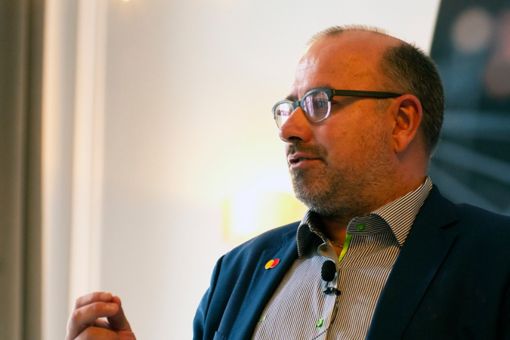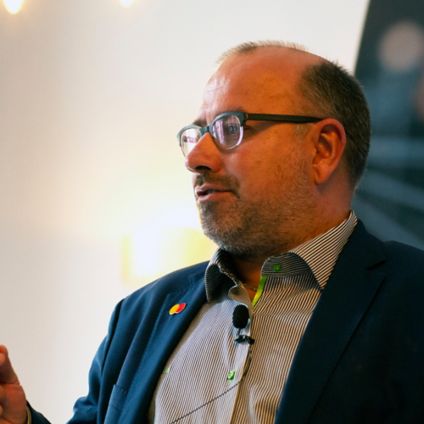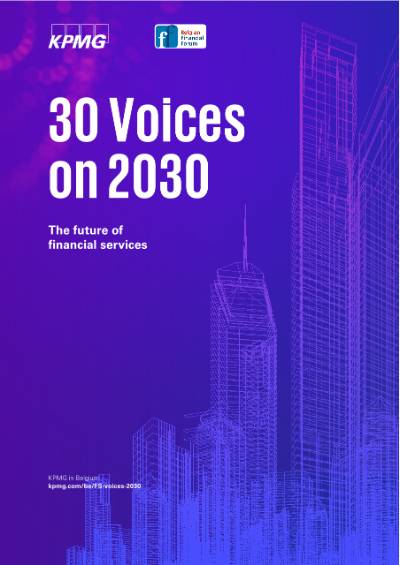“Technology is an incredible driver of change, but so is regulation. Combined, these two forces have had a profound impact on the financial services landscape, in particular, and even on life in general,” says Rigo Van den Broeck, EVP Cybersecurity Product Innovation at Mastercard.
In 2030 banking is likely to revolve around, what I call, “the verifiable truth.” There are now a lot more checks and balances in place that banks have to adhere to, because there are also a lot more data sources available and the technology to use them. It’s not enough to publish a report on your cybersecurity or devote a chapter to your ESG efforts in your annual report. It is not enough to check a company before you invest in it. You also check their supply chain to see if there is a known polluter involved or a supplier that doesn’t respect certain human rights. Everything you do and claim must be true and provable, if not, you will be called out. If not by the press, then by your customers, public opinion or your competitors.

Rigo Van den Broeck
EVP Cyber Security Innovation Mastercard
This puts serious pressure on existing banks. It is also one of the reasons why some of the main digital giants decided not create their own banks. Banking involves enormous amounts of regulation and red tape, and it is also a typical volume business. You need a large client base and local presence to survive. That does not come easy or cheap. I’m not saying that tech companies or fintechs don’t have a place in the banking landscape. They certainly do, but probably more as enablers and providers of services, platforms and technology, not as banks.
Fintechs have a place in banking, more as enablers and providers of services, platforms, and technology than as banks

Trust
There is also a trust issue at play. Mastercard is firmly and foremost a technology company. We are a “trust broker” for corporates. We are an enabler that lets other companies go about their business, we give them room to scale, and we make their operations safe. But we are not a bank ourselves.
Take crypto for instance. Our job in this field is to make crypto trustworthy and technologically and environmentally safe for those who want to use it. These days crypto is a payment trail, along with other payment trails. But has it blown all other payment rails out of the water? No. Cryptos and CBDCs represent no more than ten percent of the payment market. But the good thing about them is that they are a driver of innovation. For instance, blockchain helps us solve problems that we could not solve in an efficient way ten years ago.
Asia
In Europe, we did not adopt the Chinese banking model, with their super apps that offer everything in one place. The reason for this is very simple: the way this model works and deals with privacy and safety is incompatible with our privacy standards. It is very intrusive. We have moved to a model where people become the owner of their own (digital) identity again. The consumer decides what he shares with whom, when he shares it and how long. This is important for banks, because in banking, identity is the entry point for everything. The government is at least as crucial in this respect. They will be at the origin, because they are the only ones that have the absolute truth about someone’s identity. The role of the private sector is to unlock this data in a safe way and leverage it. And this, of course, comes more naturally to a financial services and technology company than other industry sectors.
I already stated that there is more regulation than ever these days and, contrary to popular belief, that is not always a bad thing. Regulation not only regulates, but it also aligns, enables and makes sure that corporations do the right thing. It sets standards that facilitate cooperation, make everything comprehensible and attract investments. Good regulation also evolves over time, considers technological progress and adapts.

Regulation not only regulates, but it also aligns, enables, and makes sure that corporations do the right thing

Everything is a matrix
Finally, we must talk about the impact of a changing society. The gender bias has not been eradicated. Most products and services are still designed from a man’s point of view. Board rooms, including those of banks, are still largely made up of men. This can lead to risk aversion and lost opportunities. If everyone is the same and thinks in the same way, there is a greater chance that they miss opportunities that someone with a different background and mindset might have spotted.
However, this is slowly changing. We now make better use of scarce resources, and we have developed an industry that is supported by alternative production methods. At the same time, people’s awareness about environmental issues has become much more front and center. We all tend to take a pragmatic approach. We love solar power, but we cannot live without our Wi-Fi. The problem is: everything has become a matrix. Every topic you touch, plays out on a vertical and a horizontal axis. You have to look at every challenge in a multidimensional way. The times when you could assess a problem in exactly one way and propose exactly one solution is over. Everything is multilayered now. The complexity of the world forces you to think with different perspectives in mind, be it generational, cultural or other. And that is not easy, but it is extremely interesting.
About the interviewee
Rigo Van den Broeck holds a Master’s Degree in Applied Economics from KULeuven and started his career at Banksys and KBC. In 2006 he switched to Mastercard, where he now assumes three different roles. He is Executive Vice President for Security Product Innovation, he’s the operational CEO at RiskRecon, a wholly owned Mastercardsubsidiary that develops software for risk assessments, and he represents Mastercard at the FinSec Innovation Lab, an Israeli startup accelerator for fintech and cybersecurity companies.





